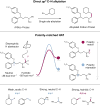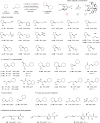Selective sp3 C-H alkylation via polarity-match-based cross-coupling
- PMID: 28636596
- PMCID: PMC5655994
- DOI: 10.1038/nature22813
Selective sp3 C-H alkylation via polarity-match-based cross-coupling
Abstract
The functionalization of carbon-hydrogen (C-H) bonds is one of the most attractive strategies for molecular construction in organic chemistry. The hydrogen atom is considered to be an ideal coupling handle, owing to its relative abundance in organic molecules and its availability for functionalization at almost any stage in a synthetic sequence. Although many C-H functionalization reactions involve C(sp3)-C(sp2) coupling, there is a growing demand for C-H alkylation reactions, wherein sp3 C-H bonds are replaced with sp3 C-alkyl groups. Here we describe a polarity-match-based selective sp3 C-H alkylation via the combination of photoredox, nickel and hydrogen-atom transfer catalysis. This methodology simultaneously uses three catalytic cycles to achieve hydridic C-H bond abstraction (enabled by polarity matching), alkyl halide oxidative addition, and reductive elimination to enable alkyl-alkyl fragment coupling. The sp3 C-H alkylation is highly selective for the α-C-H of amines, ethers and sulphides, which are commonly found in pharmaceutically relevant architectures. This cross-coupling protocol should enable broad synthetic applications in de novo synthesis and late-stage functionalization chemistry.
Figures




Similar articles
-
Synthetic and Mechanistic Implications of Chlorine Photoelimination in Nickel/Photoredox C(sp3)-H Cross-Coupling.Acc Chem Res. 2021 Feb 16;54(4):988-1000. doi: 10.1021/acs.accounts.0c00694. Epub 2021 Jan 29. Acc Chem Res. 2021. PMID: 33511841 Free PMC article.
-
Amide-directed photoredox-catalysed C-C bond formation at unactivated sp3 C-H bonds.Nature. 2016 Nov 10;539(7628):272-275. doi: 10.1038/nature19810. Epub 2016 Oct 12. Nature. 2016. PMID: 27732580 Free PMC article.
-
The direct arylation of allylic sp(3) C-H bonds via organic and photoredox catalysis.Nature. 2015 Mar 5;519(7541):74-7. doi: 10.1038/nature14255. Nature. 2015. PMID: 25739630 Free PMC article.
-
Catalytic C-H functionalization by metalloporphyrins: recent developments and future directions.Chem Soc Rev. 2011 Apr;40(4):1899-909. doi: 10.1039/c0cs00070a. Epub 2010 Nov 19. Chem Soc Rev. 2011. PMID: 21088785 Review.
-
N-Heterocyclic Carbene Enabled Functionalization of Inert C(Sp3)-H Bonds via Hydrogen Atom Transfer (HAT) Processes.Chemistry. 2024 Aug 22;30(47):e202401811. doi: 10.1002/chem.202401811. Epub 2024 Aug 2. Chemistry. 2024. PMID: 39092881 Review.
Cited by
-
Formyl-selective deuteration of aldehydes with D2O via synergistic organic and photoredox catalysis.Chem Sci. 2019 Dec 4;11(4):1026-1031. doi: 10.1039/c9sc05132e. Chem Sci. 2019. PMID: 34084358 Free PMC article.
-
Revealing the nature of covalently tethered distonic radical anions in the generation of heteroatom-centered radicals: evidence for the polarity-matching PCET pathway.Chem Sci. 2024 Jun 28;15(31):12398-12409. doi: 10.1039/d4sc02602k. eCollection 2024 Aug 7. Chem Sci. 2024. PMID: 39118625 Free PMC article.
-
Regio- and chemoselective Csp3-H arylation of benzylamines by single electron transfer/hydrogen atom transfer synergistic catalysis.Chem Sci. 2018 Sep 12;9(44):8453-8460. doi: 10.1039/c8sc02965b. eCollection 2018 Nov 28. Chem Sci. 2018. PMID: 30542595 Free PMC article.
-
Enabling synthesis in fragment-based drug discovery by reactivity mapping: photoredox-mediated cross-dehydrogenative heteroarylation of cyclic amines.Chem Sci. 2018 Dec 21;10(8):2264-2271. doi: 10.1039/c8sc04789h. eCollection 2019 Feb 28. Chem Sci. 2018. PMID: 30881651 Free PMC article.
-
Photocarboxylation of Benzylic C-H Bonds.J Am Chem Soc. 2019 Jul 24;141(29):11393-11397. doi: 10.1021/jacs.9b05360. Epub 2019 Jul 11. J Am Chem Soc. 2019. PMID: 31280561 Free PMC article.
References
Publication types
MeSH terms
Substances
Grants and funding
LinkOut - more resources
Full Text Sources
Other Literature Sources

